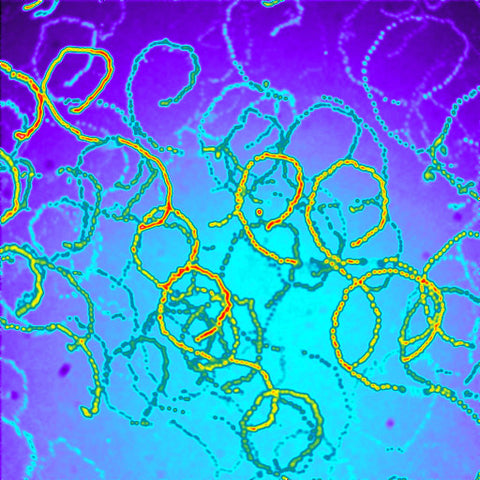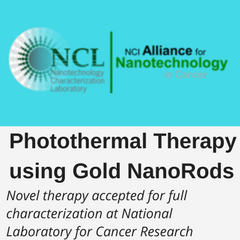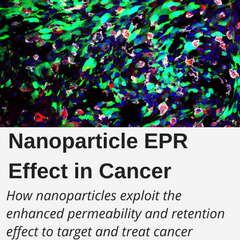Treating Cancer via Hyperthermia
Thermal therapy, where heat is used to inflict tumor cell death, is known to be a viable treatment for cancer. It has fewer side effects than chemotherapy or radiation therapy, and is less invasive than surgery. Hyperthermia can be achieved by numerous methods including: microwave, radiofrequency, high-intensity ultrasound, photothermal, or magnetic induction. However, without tight control over local temperatures or cellular targets healthy tissue can be killed just like cancerous tumor. The problem is that cancer cells and surrounding tissue both absorb light and heat at similar rates. It has been shown that cancer cells die at lower temperatures (42-45oC) than their healthy counterparts, but precise monitoring of temperature during treatment is required to prevent overheating of nearby healthy tissue.
That raises the question, how can we precisely heat to the desired cancer killing temperature zone without going over at all? To answer this question, research is turning to nano-magnets.
Hyperthermia via Magnetic Induction
Magnetic fields can initiate hyperthermia. For example, during magnetic resonance imaging (MRI) sessions the body heats slightly due to its specific absorption rate (SAR) ranging for 0.05 – 4.0 W/kg. Even after long imaging sessions at high power, however, the average temperature increase is less than 0.6oC. This is good news for imaging since it poses no health threat, but it also means there is no inherent therapeutic efficacy.

Trajectories of magnetic naoparticles under a rotating magnetic field gradient. Source: Stanford University Center for Cancer Nanotechnology Excellence focused on Therapeutic Response (CCNE-TR)
Ferromagnetic and superparamagnetic nanoparticles, on the other hand, are highly efficient heaters when subject to alternating magnetic fields, such as those employed in MRI. For use in thermal therapy applications the nanoparticles can either be injected directly to the tumor or injected systemically and allowed to accumulate at tumor sites via enhance permeability and retention (EPR) effects. Once localized they can be heated with MRI to a temperature which kills the tumor cells. Unfortunately, overheating is still a potential problem.

Blue-stained magnetic iron oxide nanoparticles selectively accumulating in the peripheral tumor area and then penetrating into tumor cells. Source: Emory University Cancer Nanotechnology Platform Partnership.
Nanoparticle Thermostats
Researchers in Dr. Ravi Silva’s lab at the University of Surrey’s Advanced Technology Institute have presented a way to safeguard against overheating. Their solution: ferromagnetic nanoparticles that heat only until a desired temperature, then no more.
How is this possible? At certain temperature thresholds ferromagnetic materials lose their magnetic properties and can no longer convert electromagnetic energy into localized heat. The temperature at which this change in properties occurs is known at the Curie temperature. Researchers in Dr. Silva’s lab have been able to tune the composition of the nanoparticles in such a way to reduce the Curie temperature into the cancer kill zone. Thus, these novel nanomaterials heat until they reach their Curie temperature, stop heating and cool below the Curie temperature, and then resume heating. In this manner tight temperature control for constant heating within the 42-45oC cancer kill zone is possible, and protects the more heat resilient healthy tissue.
As reported in the Nanoscale article “Novel nanoparticles with Cr3+ substituted ferrite for self-regulating temperature hyperthermia”, Zhang, et al. describe a variety of Zn-Co-Cr ferrite nanoparticle compositions for tuning the Curie temperature between 361.7 oC and 34.3 oC. Typically, specific tuning of the Curie temperature reduces magnetic coercivity. However, for quick, efficient magnetic heating high coercivity is required and needs to be closely matched to the alternating magnetic field strength (typically 200 Oe).
By Introducing Cr3+ to a Zn-Co ferrite system the magnetic coercivity was maintained. Their optimal formulation resulted in a Curie temperature of 45.7 oC with 174 Oe coercivity, and a SAR of 774 W/kg (>2 fold the reported standard for hyperthermia of 300 W/kg). With these nanoparticles they a maintained temperature of 44.0 oC in a 100 kHz, 200 Oe field. Even with double the field (400 Oe), a temperature of 44.6 oC was maintained. Furthermore, in vitro cytotoxicity testing confirmed their safety at biologically relevant dosage.
This work is still early stage, but these nanoparticle heaters with their built-in thermostat seem to be an answer for the the issue of temperature control in thermal therapies. Hopefully, in time full extent of their potential to revolutionize hyperthermia treatments and cancer therapy will be realized.
Explore More:


More Information:
Zhang, Wei, et al. “Novel nanoparticles with Cr 3+ substituted ferrite for self-regulating temperature hyperthermia.” Nanoscale 9.37 (2017): 13929-13937. DOI:10.1039/C7NR02356A